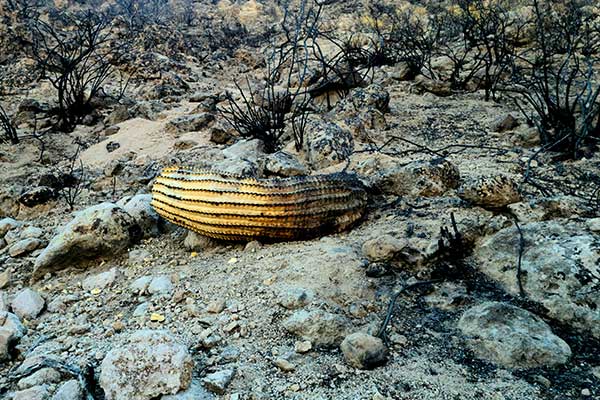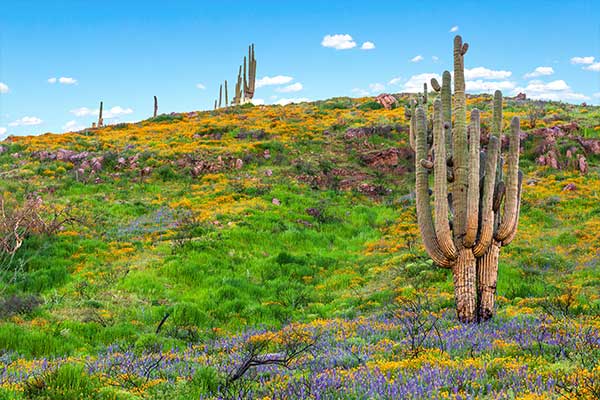Subtotal: $
Checkout
Losing the Desert
Wildfires can be a valuable conservation tool – but that depends where they occur. The sun-scorched desert is vulnerable in ways you might not expect.
By Amy Boyd
March 24, 2023
“Only YOU can prevent forest fires,” said Smokey the Bear, and as a young girl I pledged to do my best – a pledge more intuitively right and meaningful to me than the words we recited to the flag with our hands over our hearts. In a dark movie theater I had felt the terror as wildfire swept through Bambi’s forest home. Careless hunters left their campfire unattended, and the fire spread and turned into a treacherous inferno, flames dripping from the trees as the deer, chipmunks, rabbits, and squirrels ran for their lives. I was trained as a Girl Scout to be diligent about having a bucket of water ready before I even lit a match, in case our campfire should escape its circle of rocks. After marshmallows were toasted and songs were sung, we would sprinkle water onto the fire’s remains, listening for the sharp hiss as water sizzled into steam when it hit the hot coals. We learned to be persistent, to keep going until there was no steam and nothing gleamed or sparkled in the darkness when we stirred it with a stick. We were ever so vigilant – we were not going to be responsible for burning Bambi’s home. This was a good and important lesson.
Then, in my first semester of college, the coin was flipped as I learned about the importance of wildfire to many ecosystems. Grasslands evolved to coexist with fire, grasses tucking their growing meristems under the ground’s surface so the flames would burn through quickly, leaving those crucial, vulnerable points untouched. They recover rapidly, sending tender new leaves up from those generative epicenters; they benefit from the fire’s release of nutrients and the beating back of woody vegetation that might eventually outcompete the grasses, turning prairie into forest. In longleaf pine forests, the trees’ thick bark protects the cambium underneath from the heat of the flames. Resin glues shut serotinous cones on giant sequoias, and only fire can melt the resin to open the cones, releasing the seeds to start the next generation. Many shrubs have seeds that only germinate and grow after fire; they may be triggered by exposure to chemicals from the smoke, nutrients released in the ground after fire, or even directly by the intense heat. Without these triggers, the seeds lay dormant, unable to continue through their life cycle. Whole ecosystems have evolved in the presence of fire and are dependent on fire to continue; without it, these ecosystems change into something completely different, and all the species in them are impacted.
Fire is disruptive, but that disruption can be a good thing. Fire can be a valuable, even essential, conservation tool. But here’s the thing: it totally depends on where you are.
I walked through a fire-scorched landscape outside Tucson in 2020, days before the pandemic would grind everything to a sudden halt. Blackened dead shrubs and lumps of brown, lifeless barrel cactus corpses were everywhere. It was these barrels that struck me the hardest, like walking through a battle scene strewn with dead bodies. Aldo Leopold once described being an ecologist as like living “alone in a world of wounds.” Walking this trail, I thought that anyone who walked there could see the wounds and destruction, but my knowledge of the ecology of this place deepened my pain. I knew just how slowly these cacti grow. I knew they had no fire defense; although large cacti can survive an occasional small fire, repeated or particularly intense fires can kill even the largest. Recovery of the population takes a long, long time. Their seeds have no protection from fire. Barrel cacti will survive long term in the larger ecosystem if they’re preserved in refugia, small sheltered areas not reached by the fire, but if fires are too intense and widespread there are no safe places and the population may not recover.

Scorched cactus barrel in the Sonoran Desert. Photo by BASlyMan.
The area had burned hot and far and long, and the lovely old barrels had lost too much. Their apical meristems were not protected enough; the cacti would not grow again. They would stand here dead on the desiccated landscape until insects and fungi and the elements slowly worked away at them and broke them down, erasing their presence in this place. Limberbush, creosote, and mesquite also stood dead. This landscape could recover, given enough time and the right conditions. But those conditions aren’t likely: buffelgrass and other invasive species are well established, have filled in all the spaces between the native plants, and each year create a carpet of delicate tinder that allows fires to establish and spread, wide and fast.
Grassification: the word sounds to me like what easterners moving to Phoenix had done to their front yards, planting them in lush green lawns that required stealing water from ancient aquifers in order to create such a misplaced scene in the middle of the desert. Not entirely unrelated, the word actually refers to the spreading of non-native grasses through a non-grassy landscape. Buffelgrass was introduced to the western United States starting in the 1930s as cattle forage and for erosion control. Native to Africa, Asia, and the Middle East, the species was favored for its high drought tolerance and high seed production, two of the qualities that have led to buffelgrass’s spread and dominance in the desert.
Although I knew that such a big desert wildflower bloom was fleeting and rare, I didn’t know that the scene I saw that day might never happen again.
Buffelgrass disperses quickly by producing lots of seeds each year. It is highly drought-tolerant; it can hide its living meristem belowground during the dry months, only to use its stored energy to burst forward and grow quickly once rains come. It fills all the spaces in between plants in the desert with rapid leafy greenness in the wetter times. When that vegetation dies back and dries up, those spaces between cacti and mesquites and agaves are left covered with extremely flammable tinder. Lightning strikes during the summer monsoon season can ignite all that biomass, starting fires that burn fast and hot. Accounts of buffelgrass fires in Tucson alleys tell of the intense heat melting cars and chain-link fences. One can imagine, then, just what a fire of that magnitude can do to an iconic saguaro cactus wearing its tender photosynthetic tissues on its skin. Fire used to be rare and isolated in these deserts, so the inhabitants never evolved protections from it. Buffelgrass fires leave devastation in their wake, but only for the native plants – the buffelgrass itself thrives in the wake of fire, growing quickly from those underground meristems as soon as the rains return, outcompeting any slow-growing native plants that might attempt to recolonize the area. It becomes a feedback loop: buffelgrass creates the conditions for hot, wide-ranging fires, and those fires set the stage for further dominance by buffelgrass. Recurring fires will make it impossible for the desert to recover, and the ecosystem will end up transformed into a monoculture grassland in place of the diverse and unique desert it had been.
In 1998, the rains came often to the Sonoran Desert, all winter long. This is the formula for casting wonder across this landscape. We knew the magic was coming; we heard the daily rainfall measurements, watched the clouds overhead, saw the tiny emerald sprigs of all kinds springing up all over the ground, in between the rocks. We had learned to identify them by the shape and color of their tender young leaves: the poppies with their stringy blue-green divided leaves like lace along the ground; the lupines with their darker sprays of long leaflets coming out of a central point like the spokes of a wheel, each one delicately folded in half. We watched as they grew fast, trying to complete their lives before things dried up, before the heat settled in. We held our breath, watching for the next rainfall, hoping it would keep coming and these tender youngsters would find their splendor.
And they did. Grand expanses of bright color replaced the dry, brown landscape so familiar to those of us who spend our time scrambling around in the desert. Rich swaths of orange and pink, violet and fuchsia, gold and green spread out in the open spaces before us. All our thoughts of scientific names and data were overwhelmed by the magnificence, by the expected unexpected grandeur of it all. It was like Mardi Gras among all the subtler holidays.

Saguaro cactus and wildflowers in the Sonoran Desert. Photo by Monica Lara.
The chatter around our lab each day that spring was about where to find the best wildflower splendor. One day a member of our group, a consummate botanist and photographer, urged us all to drive out toward Yuma, to the Mohawk Dunes, immediately, without delay. He had been there that day and was agog and effusive about the spectacle he had witnessed. The next morning I was up early, driving my little red Mazda hatchback west on I-8, 230 miles across half of Arizona.
The drive was easy, through Gila Bend – an actual town – and then through a series of crossroads with names but little else: Piedra, Sentinel, Dateland, Tacna. I was almost to California when I finally saw the dunes out to my right, undulating to the horizon. I pulled my car over on the shoulder of the empty interstate and parked. The sand was beige and would stay that way, as little grows in these piles of sand during most of the year, most years. That day, though, the dunes were strewn with pillows of brilliant fuchsia verbena and lush evening primrose with giant white blooms. Both species use scent to summon all the nectar-sucking moths in the area. As soon as I opened my car door I was bathed in their warm, flowery aroma. Tall stalks of desert lilies stood upright here and there like sentinels, their spikes of white star-shaped flowers held up high to summon passing pollinators.
I wandered the dunes, agape at the show they were putting on, breathing slow and deep to take in as much as I could of the fantastic aroma. I knew that I would likely be living far away the next time there would be such a good desert wildflower year. This was my one chance, and I soaked it in while I could. My Minolta 35-millimeter camera hung heavy from the back of my neck, ready to capture as much as I could of the moment. Despite the cost of film and my meager student salary, I was not miserly with my shots as I recorded the fiesta of color and fertility. The glory would fade in days, disappear in a week or so. For that moment, though, I bathed in a world of vibrant color and heady scent.
Although I knew that such a big desert wildflower bloom was fleeting and rare, I didn’t know that the scene I saw that day might never happen again. In 2005 the rains were good again, and the Mohawk Dunes were once again covered in green. This time, though, there were no bright colors. This time, the green was not evening primroses, sand verbena, and lilies. Instead, it was Sahara mustard, a new and terribly pernicious invader. It spreads quickly through seed, sends tap roots down deep so that it is almost impossible to eradicate. Its flowers function well but are inconspicuous, tiny spots of pale yellow. They do not call out to the hawkmoths; they do not create nectar for these giant hummingbird-like insects. It is likely that the hawkmoths are now as scarce and absent as the colorful wildflowers.
What’s more, the mustards leave their crispy, desiccated bodies aboveground when they go dormant, pulling their life-force down to stout, deep roots. They fill the empty spaces that used to be simply spreads of sand in the times between good soaking rains, and they fill them with delicate tinder that will catch fire easily and spread flames across the dunes. Their roots are protected; the plants come back quickly in the next rain. But the native plants that would have been here in their place – they are not so protected. This ecosystem is transformed. The grand displays I saw on these dunes may never return.
The sun-scorched earth of the desert is tender in ways we do not expect. Compared to the softness of our unprotected skin, the prickly-pointy-sharp-thorny-barbed-bristled beings scattered across that hard, stony landscape seem well defended, standoffish, stiff – even grumpy. Defense is what they are built for. And yet, introduce them to fire and they are fragile as babies, wearing their chlorophyll on their smooth, tender surfaces, flame carried across their face from spine to spine, each meristem tucked in a nest of spines that protect it from cold but concentrate the heat of fire.
The soft fronds of buffelgrass across the desert landscape look much more vulnerable than the sturdy, solid lumps of spine-covered cacti, and yet they are the ones that will write the story of this place going forward. They will dominate, hiding away their meristems like treasures just below the ground, letting the fire rage above, waiting for their moment to surge forth and take over, to be fruitful and multiply. They will fill the spaces that were empty. We may see that emptiness as a vacancy ready to be filled with abundance, but those spaces are the grace that buffers. They allow clearance for spectacular wildflower flourishings in the wet years, and they separate here from there and keep flames from spreading across the desert floor and consuming everything in their path.
Already a subscriber? Sign in
Try 3 months of unlimited access. Start your FREE TRIAL today. Cancel anytime.







Chris
I very much appreciate this article. Thank you. I feel so much sadness around what is happening to Earth. Thank you for sharing this experience. This is a microcosm of the reality that is repeated all over the world in uncountable ecosystems.